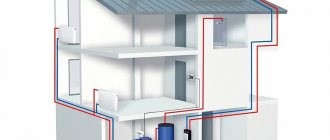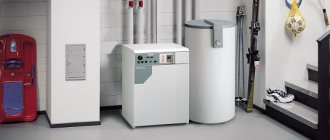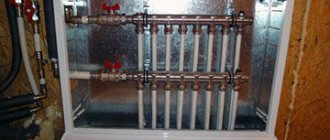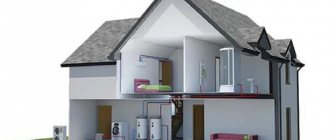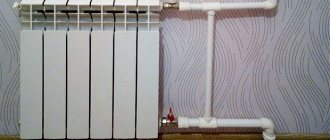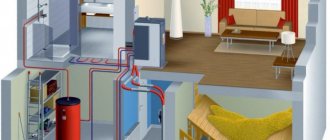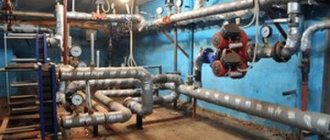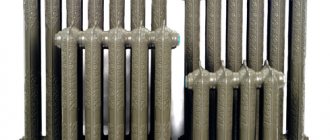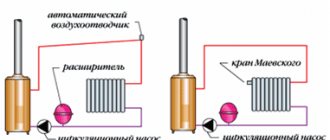Classification of heat supply systems
In science, many options for systematizing communications are accepted depending on the parameter being studied. For us, first of all, it is important that there is an open and closed heat supply system. It can also be centralized (within a block, district, settlement or even an entire region) and decentralized (individual or local). Based on the quality of water supply, systems are divided into municipal and industrial. The total number of classifications is much wider, but they are not relevant to the topic under consideration.
Features of an open system
It is characterized by the circulation of coolant obtained from common communications. An open hot water supply system is when water enters the batteries from the main hot water pipe. From the same source from which hot water goes to residents' taps.
The operation of the system is based on natural circulation. Due to physical phenomena, the cooling water, acquiring greater mass, will displace the hot flow, giving it acceleration. In some cases (in large systems), circulation is forced using pumps.
Open type heating is usually installed in high-rise buildings. The main advantage here is that there is no need for special mechanisms or devices for heating the coolant. For private households, such a system will be unnecessarily expensive, because the heating pipe will have to be connected to some high-rise building or a hole must be dug to connect it to the main line.
Main advantages
Let's list the main advantages:
- energy independence and centralized supply;
- smooth circulation of the carrier in the system without sudden pressure surges;
- ability to work in case of emergency due to redundant hot water mains.
However, an open heating system is not ideal.
Flaws
The main disadvantages include:
- high heat loss and, accordingly, unnecessary costs for heating water;
- dependence on the performance of large highways; in the event of an accident, the supply of hot water supply may stop in a large number of houses;
- water quality decreases due to defects in pipelines, in particular, rusty pipes;
- branched open systems require constant monitoring and careful calculations of supply volumes, heating temperatures and pressures.
Let's consider an alternative option.
Union of Housing, Communal Services and Energy Enterprises of the Krasnoyarsk Territory
In accordance with paragraph 27 of Article 2 of the Federal Law of December 7, 2011 No. 416-FZ “On Water Supply and Sanitation” (hereinafter referred to as Law No. 416-FZ), a centralized hot water supply system is a complex of technologically interconnected engineering structures designed for hot water supply by taking hot water from the heating network (hereinafter referred to as an open heat supply system (hot water supply) or from hot water supply networks, or by heating water without taking hot water from the heating network using a central heating point (hereinafter referred to as a closed hot water supply system).
At the same time, a non-centralized hot water supply system is structures and devices, including individual heating points, with the use of which hot water is prepared by the subscriber independently (clause 12 of Article 2 of Law No. 416-FZ).
For example, houses with heat exchangers belong to a non-centralized hot water supply system, when thermal energy and cold water are supplied to an apartment building, while hot water is prepared using in-house engineering equipment (IHP), which is part of the common property.
Many management companies and homeowners associations have had a problem determining the type of system (centralized or non-centralized) when providing information for calculating standards for thermal energy consumption for heating cold water (drinking or chemically purified water) for the provision of public services for hot water supply and incorrect interpretation of the Rules for the provision of public services owners and users of premises in apartment buildings and residential buildings, approved by Decree of the Government of the Russian Federation dated May 6, 2011 No. 354 (hereinafter referred to as the Rules).
According to the current tariff legislation, hot water tariffs are set as two-component, depending on the type of hot water supply system.
Tariffs for hot water in open heat supply systems (hot water supply) are set in the form of two-component tariffs using a coolant component and a thermal energy component (clause 5 of Article 9 of the Federal Law of July 27, 2010 No. 190-FZ “On Heat Supply”).
In accordance with paragraph 88 of the Fundamentals of pricing in the field of water supply and sanitation, approved by Decree of the Government of the Russian Federation dated May 13, 2013 No. 406, tariffs for hot water in closed hot water supply systems are established in the form of two-component tariffs for hot water, consisting of a component for cold water and component for thermal energy.
At the same time, paragraph 6 of clause 38 of the Rules determines that in the case of establishing two-component tariffs for hot water, the amount of payment for public services for hot water supply is calculated based on the sum of the cost of the component for cold water intended for heating in order to provide public services for hot water supply, and the cost component for thermal energy used to heat cold water for the purpose of providing public services for hot water supply (formula 23 of Appendix 2 of Regulation No. 354).
The specified procedure for determining the amount of payment for utility services for hot water supply can only be applied to closed hot water supply systems.
It should be noted that the Ministry of Construction of the Russian Federation has prepared a draft resolution of the Government of the Russian Federation, according to which changes will be made to Rule No. 354, according to which the amount of payment for hot water supply will be determined based on the cold water component (coolant) and the thermal energy component. The specified draft resolution is posted on the official website: www.minstroyrf.ru/docs/
In the absence of centralized hot water supply, the provisions of paragraphs 5-7 of clause 54 of the Rules are applied, according to which in the case of independent production by the contractor of public utilities for hot water supply (in the absence of centralized heating and (or) hot water supply) using equipment that is part of the common property of the owners of the premises in an apartment building, the amount of consumer payment for utility services for hot water supply (in the absence of centralized hot water supply) is determined in accordance with formula 20 of Appendix 2 to these Rules as the sum of two components:
the product of the volume of hot water consumed by the consumer, prepared by the contractor, and the tariff for cold water;
the product of the volume (quantity) of a utility resource used to heat cold water for the purpose of providing a utility service for hot water supply, and the tariff for a utility resource.
At the same time, one of the components of formula 20 of Appendix 2 to Rules No. 354 is the specific consumption of the v-th utility resource for heating water, approved in accordance with the legislation of the Russian Federation by the authorized body, the standard consumption of the v-th utility resource for heating water for the purpose of providing a utility service for hot water supply .
The requirements of paragraph 32(1) of the Rules for establishing and determining standards for the consumption of utility services, approved by Decree of the Government of the Russian Federation dated May 23, 2006 No. 306 (hereinafter referred to as Rules No. 306), establish that the authorized body establishes a standard for the consumption of thermal energy used to heat cold water to provide public services for hot water supply, taking into account the type of hot water supply system (open, closed).
At the same time, the requirements for establishing the standard consumption of the v-th communal resource for heating water in order to provide public services for hot water supply for non-centralized hot water supply systems , as specified in paragraph 54 of Rules No. 354 and in formula 20 of Appendix No. 2 to Rules No. 354 , are missing.
In this connection, in column 11 “Type of hot water supply system” of the data register for apartment buildings and residential buildings for calculating the standards for thermal energy consumption for heating cold water for the provision of public services for hot water supply, which is necessary for filling out by organizations engaged in managing apartment buildings houses, if there is an individual heating point in an apartment building, which is part of the common property, with the help of which hot water is produced in the house using a communal thermal energy resource (non-centralized hot water supply system), please indicate the type of hot water supply system - closed .
At the same time, in the indicated open hot water supply systems, the communal resource is indicated in the form of chemically purified water (coolant in water).
In closed hot water supply systems, a communal resource in the form of cold water is indicated for the provision of public hot water supply services (including in houses with individual heating points).
Closed hot water system
Requires your own heater in the apartment. A dead-end hot water system works on the principle of taking cold water from a common pipeline, which then passes through special equipment that performs heating. A closed hot water supply system is a more economical solution. The resident will be able to independently regulate the heating temperature.
What types of heaters are there?
There are two main options that are most common. Let's consider individual types of water heating equipment.
Flow devices
An example of this type is a regular geyser. The principle of operation is aimed at instantly heating the water passing through the water heater. The inconvenience of working with such a device is due to the fact that it must be turned on every time you need to use hot water. In this case, the crane should be running at this moment. Modern water heaters turn on automatically, but the gas wick must be constantly burning.
Heating devices
Storage tanks become a more economical solution. Such a device is larger than a speaker. It contains a container in which volumes of water are accumulated and gradually heated to the desired temperature. At the same time, heating in the tank is maintained with insignificant energy consumption. The disadvantage of the equipment is that it takes considerable time to achieve an acceptable temperature level. Boilers are usually powered by electricity.
Types of hot water supply systems
Hot water supply systems are divided into:
- Centralized.
- Decentralized.
The first type is a circuit consisting of a boiler room and a large number of consumers. As a rule, a centralized scheme is used to supply water heated to a certain temperature to apartment buildings. The decentralized type of hot water supply, on the contrary, is autonomous, where the liquid is heated in close proximity to the water distribution elements.
DHW can also be of the following types:
- Open.
- Closed.
The open type of water heating installation is a scheme in which liquid heated to a certain temperature is taken from the heating circuit. In a closed circuit, cold liquid coming from the water supply is separately heated. Both DHW options have advantages and disadvantages, for example, for a closed circuit you will need to use additional equipment, but for an open circuit, the water quality will not be too high.
Calculation and recycling procedure
In order for the DHW system to be designed correctly, the following must be kept in mind.
- The drawing shows the circulation rings. They close at the thermal unit.
- There are 2 pipelines: supply and circulation.
- On the longest section of the hot water supply route, zones of maximum circulation heat consumption are noted.
- The diameter of the pipes cannot be less than 1.5 cm. Moreover, they must be 1-2 sizes larger than the diameter of those in the supply section. This is done to avoid air locks.
When calculating a heating installation, you need to keep in mind that an open system will be effective only at a short distance from the intake site and when the valve supplying boiling water is opened frequently. Otherwise, the consumer will receive cooled water.
Implementation
What hot water supply schemes with recirculation are possible in apartment buildings and private buildings?
Apartment buildings
To create continuous circulation of water, the DHW system needs to be looped.
In apartment buildings this is achieved as follows:
| Image | Description |
| There are two hot water dispensers throughout the house. The risers are connected to them one by one. As an option, only DHW risers are connected to one of the bottlings, and only risers with heated towel rails are connected to the second. |
| DHW risers (optional DHW and heated towel rails) are connected by jumpers on the top floor. A group can consist of 2-4 risers. An air vent (Mayevsky tap) is mounted at the top point of the jumper, allowing the air to bleed off that is preventing circulation. |
It’s interesting: in some houses built in the late 80s, the author observed jumpers between the hot water supply risers, placed in a cold attic. The solution raises doubts about the adequacy of the authors: at street temperatures of -30°C and below, they freeze within an hour after stopping circulation in the hot water system (for example, for emergency repair of a valve in an elevator unit).
It is clear that the described water supply scheme with recirculation will not work without a pressure difference.
How it is provided:
- Outside the heating season, the DHW is switched on between the supply and return lines;
Summer mode: DHW circulation between the supply and return lines
- During heating operation with such a connection, the hot water supply system will represent a bypass for the heating system, catastrophically reducing the drop in the water jet elevator. Therefore, the DHW is connected depending on the temperature of the water from supply to supply or from return to return, and the difference is ensured by retaining washers installed on the flanges between the taps.
Modern elevator unit with circulation connections
Reference: a retaining washer is a steel plate with a hole in the middle. The hole diameter is usually 1 mm larger than the elevator nozzle diameter. When water moves through the washer, a difference of 0.1 - 0.3 kgf/cm is created on it, which is quite sufficient for circulation in the hot water system.
If the risers are airy
What should I do if, after resetting the hot water supply system, the air pocket remaining in the risers prevents circulation and the heated towel rails remain cold?
To bleed air, use the Mayevsky valve at the top point of the jumper. However, to access it you need to get into the upper apartment via the riser, which is not always possible.
Here are simple step-by-step instructions that will help you fix the problem yourself:
- We block any of the hot water supply risers connected by a jumper;
- We open one, or better yet, two hot water taps in any apartment along this riser all the way. The air plug flies out through the mixer at the front of the water flow;
Open the faucet completely and the air will fly out of the riser at the front of the water flow
- We start the risers in normal mode.
Private houses
What hot water recycling schemes can be implemented in a private house with autonomous hot water preparation? Quite predictably, a minimum power circulation pump (from 25 watts) will be responsible for creating circulation pressure in such a system.
Circulation in the DHW circuit can be ensured by a minimum power pump
The DHW circuit must be looped along its entire length: after the plumbing fixture farthest from the water heater, the filling returns to the starting point. But the connection diagram for the water heater depends on whether it has an additional outlet for recirculation.
Diagram for a boiler with a pipe for connecting a recirculation circuit
The presence of three pipes for connecting DHW and cold water is typical for most indirect heating boilers and some storage electric water heaters.
Boiler with additional outlet for recirculation
The closed circuit is supplied only with a circulation pump: since the temperature of the water in the circuit is constant after its start, the problem of thermal expansion of water does not have to be solved, and if so, a safety valve and an expansion tank are not required.
Is it possible to use a regular boiler with two outlets (for DHW and cold water) in such a scheme? Yes, but in this case the wiring will be noticeably more complicated.
Water supply with recirculation: diagram for a boiler with two pipes
- A three-way thermostatic mixer is responsible for maintaining a constant water temperature in the recirculation circuit. As it cools, he mixes in hot water from the boiler;
The three-way thermostat mixer is capable of providing a constant outlet water temperature at any inlet temperature
- To compensate for the flow of hot water, cold water is supplied to the three-way mixer;
- Check valves limit the movement of water in the circuit in one direction, regardless of its flow.
Useful: it makes sense to install an automatic air vent at the top point of the DHW circuit. Air pockets in the presence of a pump will not interfere with circulation, but they can become a source of annoying hydraulic noise.
Design and appearance of an automatic air vent
Use of heating points
This is a separate room. It must contain thermal power plants connected to the heating network. Heat exchangers for hot water supply in an apartment building must have tools for regulating consumption, distributing hot water among apartments, and setting up the equipment itself.
An individual heating point in an apartment building is usually located in the basement. Previously, the system was installed in attics. In the event of a breakthrough, streams of boiling water spilled throughout the room and flooded the apartments. If an emergency occurred at night, it could lead to serious injuries or even casualties.
An alternative option is to build a heating station in a separate building next to the building. The purpose of the equipment is to convert the coolant, regulate the supply of hot water or heat, distribute the resource among apartments and turn off its supply.
Water heating equipment
A standard water heater can be used for domestic hot water or heating. In case of equipment breakdown, housing and communal services tariffs will not be reduced. Repair work will also fall on the shoulders of consumers, who are obliged to monitor its good condition.
Thermal energy component
It is responsible for heating cold water. Moreover, counters are not installed on the component. Before calculating the thermal energy for DHW, the following parameters must be taken into account:
- tariff for hot water supply;
- system operating costs;
- costs for coolant transfer;
- calculation of heat loss.
Also taken into account is the fee for regular water supply, calculated on the basis of consumption (RUB/cubic meter).
